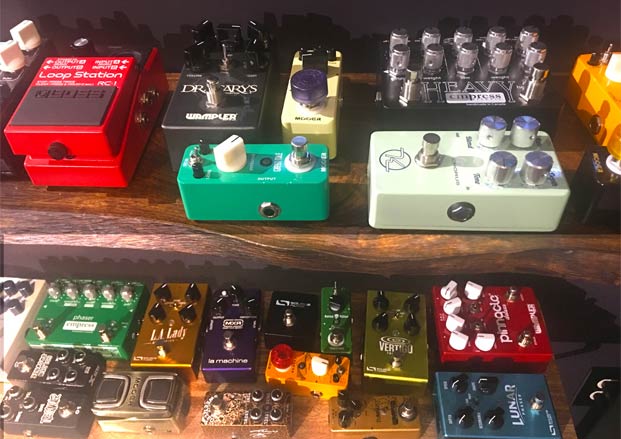Why You Shouldn't Use Effects When You Practice

One of the most difficult things to do as an improving guitarist is to practice consistently. In fact, that’s the hardest thing I know how to do.
The second hardest thing to do, in my opinion, is keeping the amount of guitar pedals and effects to a minimum during practice sessions.
This means no hiding behind a wall of delays, flangers and phasers while you rip through your scales at 300bpm.
It’s extremely tempting to stomp all the pedals on your board, because after all, guitarists like John Petrucci or Joe Satriani have a little more going on under the hood than a bit of overdrive and some reverb, so why shouldn’t we? The difference is they can control and manipulate those effects to their advantage, rather than depend on them to execute their licks and riffs.
When you practice, you should simplify your signal in order to sharpen your playing technique, and then build on that foundation. The one exception to this idea is loop pedals, as they can be very helpful in building your rhythm and creativity.
Also, I’m not saying you shouldn’t go crazy from time to time with your pedals and experiment, because in the end, playing guitar should be fun. After all, Tom Morello, Mike Einziger and Alex Lifeson wouldn’t be the guitar icons they are today without their signature, over-effected solos and riffs.
I have to say, though: the satisfaction of engaging your array of effects after you’ve trained in the dojo of dry guitar tone is very sweet, and I recommend you give it a try.
All the latest guitar news, interviews, lessons, reviews, deals and more, direct to your inbox!
Tyler Larson is the founder of the guitar-centric brand Music is Win. His insightful, uncomplicated guitar lessons and gear demonstrations along with entertaining, satirical content about life as a musician receive tens of millions of video views per month across social media. Tyler is also the creator of the extremely popular online guitar learning platform, Guitar Super System. A graduate of Berklee College of Music, Tyler has been teaching guitar for over a decade and operates a production studio in Nashville, TN.
Tyler Larson is the founder of the guitar-centric brand Music is Win. His insightful, uncomplicated guitar lessons and gear demonstrations along with entertaining, satirical content about life as a musician receive tens of millions of video views per month across social media. Tyler is also the creator of the extremely popular online guitar learning platform, Guitar Super System. A graduate of Berklee College of Music, Tyler has been teaching guitar for over a decade and operates a production studio in Nashville, TN.
